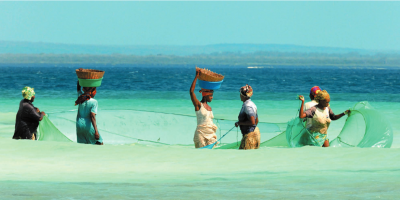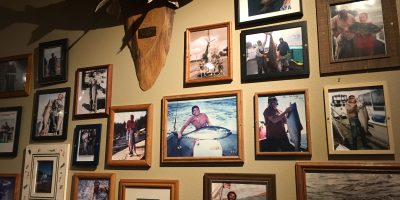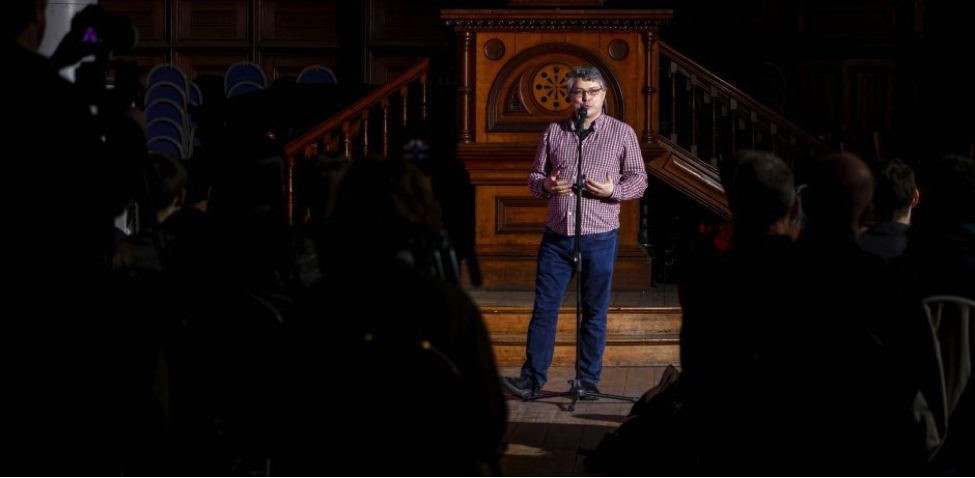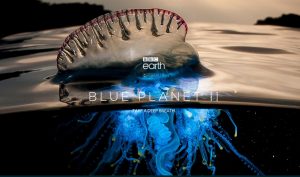BY QUILLEN TRAN, AQUATIC & FISHERIES SCIENCE UNDERGRADUATE, AND LAUREL YRURETAGOYENA, BIOLOGY UNDERGRADUATE
Art is a powerful tool, with the ability to connect with a wide audience. Think about the last time you sat back in your chair, your world turned upside down by a piece of writing. Or the time you couldn’t tear yourself away from a book that you picked up. Or the last time you cried in a movie theater. The strength of those art pieces came from the emotions they evoked, from the way they transported you, from the new ideas and connections they created that made you think differently. There is an innate human desire to connect emotionally with what we see, read, and hear. However, the innate human dimension to science often gets hidden behind dry and complicated writing. To better communicate science, we need art.
Adding an ‘A’ to ‘STEM’

Our two brain hemispheres: colorful swirls representing our creative right brain, and black circuitry representing our analytical left brain. Credit: artsanywhere.com
As scientists, we should constantly be asking: how we can get our message across in an innovative way that is interesting, understandable, and believable in a world riddled with uncertainty, doubt, and plenty of noise? During the 2018 Bevan seminar series, many of the speakers touched on ways to improve science communication, and the importance of relaying science to a broader audience.
The closing speaker of the Bevan Series, Liz Neeley – a marine biologist by training and executive director of The Story Collider – argues that the world is full of people hungry for knowledge – people who are leaders and decision makers, who are ready to take this knowledge and their influence and apply it. Art can be used to tell a story, give voice to an experience, and bridge communication gaps. The Story Collider is dedicated to telling true stories about science from all kinds of people, with the goal to make science accessible to everyone.
Science as a narrative
The dry, technical definition of a narrative is “a format of communication involving a temporal sequence of events influenced by the action of specific characters” (Dahlstrom and Ho 2012). But really: it’s a story. And narrative stories have power.
We love a story that makes us feel emotion – the worst thing a story can do is make the reader say “I’m bored.” Whether a story makes us laugh or cry or hide under the covers, it’s the emotional connection we have that draws us back to them again and again. Stories can induce transportation – the technical term for being so lost in a story that you feel like you’re really there. And the best ones include compelling characters that we can identify with and feel connected to.
All of these factors are why narratives in science communication have been shown to improve the comprehension, engagement and interest of non-scientists in the topic at hand. Science is also uniquely suited to narratives, because they are most believable when they are, as Liz would say, “linked by profound causality.” Information placed at causal locations in a story – places where it influenced future events – was more likely to be assumed as true. Since much of what we as scientists do is attempt to prove causal links between different variables, scientific discovery can lend itself well to a believable narrative (Dahlstrom 2015).
“The best available science tells us that stories are powerful. Science never tells us what to do, but it tells us what kind of questions to ask.”
-Liz Neeley
However, the power of narrative brings up ethical concerns. For example, a problem that some scientists have with pop science is the level of dramatization and fictionalization. How much is acceptable before the narrative strays too far from the original data and the scientific truth? Another issue relates to the power of a narrative to change people’s beliefs, and whether scientists should use it to influence people.
We are often taught that our job as scientists is to strictly relay information without biases. But Dahlstrom and Ho (2012) raise the question: is the purpose of using narrative for comprehension or persuasion?
As the public’s distrust of science grows, we must be careful in how we proceed. However, there are gray areas. Groups like The Story Collider seek to make science accessible to all people by hosting scientists who tell stories about mundane events like getting their Jeep stuck in the mud, and non-scientists who tell stories about how despite their lack of research credentials, science has powerfully intersected with their lives. This approach is working.
Narrative is a tool, and tools can be used in many different ways. Whether or not you think that scientists should be trying to persuade the public of one view or another, we should be doing everything we can to get our stories out there, to present our findings to a wider audience, to connect with the public in new and different ways, and to share the beauty of our work.
“How do we get people to trust us? How do we get people to care about something they don’t care about already? Well, our own science tells us that stories are one of the tools we should consider.”
-Liz Neeley
A powerful communication tool
This is our challenge as scientists: to become more relatable to a general audience and share information based on shared human values. Art is already being utilized in many creative and effective ways to bridge the gap between scientists and the public–not just by the Story Collider, but by photographers like Paul Nicklen, documentaries like Blue Planet, and authors like those involved in PLoS One’s Conservation Stories from the Front Lines.
Art in all of its forms should be taken seriously. Too often we put science first, but it is art that touches lives, not dry, jargon-stuffed journal articles. Your work is so much more than your tables of statistics. Sharing your science through the art of storytelling can be a powerful way to change the world around you.
“Truth and beauty: we can have robust, deeply considered, careful, empirical science. But then, we can also present it in beautiful and compelling ways that get people excited.”
-Liz Neeley
Citations:
Dahlstrom, M. F. (2015). The moderating influence of narrative causality as an untapped pool of variance for narrative persuasion. Communication Research, 42(6), 779-795.
Dahlstrom, M. F., & Ho, S. S. (2012). Ethical considerations of using narrative to communicate science. Science Communication, 34(5), 592-617.
Green, M. C., Brock, T. C., & Kaufman, G. F. (2004). Understanding media enjoyment: The role of transportation into narrative worlds. Communication Theory, 14(4), 311-327.
Nabi, R. L., & Green, M. C. (2015). The role of a narrative’s emotional flow in promoting persuasive outcomes. Media Psychology, 18(2), 137-162.








Liz
Dear Quillen & Laurel, thanks so much for this thoughtful write-up of my talk and suggested papers! You’ve done a great job capturing the arguments I am developing.
One thing I’d like to challenge you to think about is the first piece of artwork in the piece – the left brain/right brain dichotomy is a pretty image and hints at important dualities in human nature, but does it hold up? Is there good science behind that idea? I strongly encourage you to dig into the history of where this comes from. The brain is a marvelous, complex, and deeply integrated system. The real story is much better than the superficial (and wrong) version.